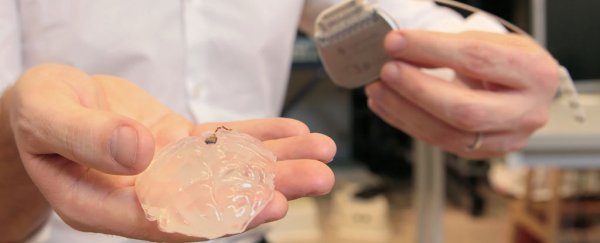Scientists have used a wireless brain implant to bypass the spinal cord injuries of two paralysed rhesus macaques, giving them the ability to walk again.
The system – which wirelessly transmits decoded brain signals to stimulate the muscles responsible for leg movement – represents the first time a neural prosthetic has restored locomotion in a primate.
While the brain-spinal interface has only been tested on macaques so far, the team behind the research says one day the technology could help restore the ability to walk in humans paralysed by spinal cord injuries.
"The system we have developed uses signals recorded from the motor cortex of the brain to trigger coordinated electrical stimulation of nerves in the spine that are responsible for locomotion," says engineer David Borton from Brown University.
"With the system turned on, the animals in our study had nearly normal locomotion."
When we walk, electrical signals that originate in the brain's motor cortex are sent down to the lumbar region in the lower spinal cord. Once there, they activate motor neurons that help us coordinate the movement of leg muscles necessary for walking.
But injuries to the upper spine can sever this communication channel between the brain and the lower spinal cord – meaning the signals can't get through to coordinate our leg movements.
The goal of the team – which involved collaborators in Switzerland and Germany – was to restore this lost movement, by sending the same brain signals wirelessly, bypassing the severed nerves altogether.
In the system, which builds upon previous sensor technology called BrainGate, a pill-sized electrode array is implanted in the brain to capture movement signals generated by the motor cortex.
A wireless sensor then broadcasts the signals to a computer, which decodes them, before sending them wirelessly back to an electrical stimulator implanted in the lumbar spine – below the area of spinal injury.
This stimulation signals to spinal nerves, which activate leg muscles.
To calibrate the system, the researchers implanted the neural interface in healthy macaques, so they could capture the animals' brain signals that correspond to normal leg movement and locomotion.
They then tested the implants on two animals that had temporary paralysis due to spinal cord lesions in their thoracic spine (the upper and middle back).
With the interface and receiver activated, the animals spontaneously began to move their legs and could walk on a treadmill with almost normal motion, as you can see in the video below:
According to the researchers, the ability to restore movement without wires is crucial, as wired brain-sensing systems can restrict freedom of movement.
"Doing this wirelessly enables us to map the neural activity in normal contexts and during natural behaviour," says Borton. "If we truly aim for neuroprosthetics that can someday be deployed to help human patients during activities of daily life, such untethered recording technologies will be critical."
It's a pretty huge accomplishment, but the team cautions that there are a number of limitations with the system so far.
The interface still requires a separate computer capable of decoding the signals, and more significantly, the wireless signals currently only get sent one way: from the brain to the legs.
Of course, in regular walking, our legs and feet also send sensory information back up to the brain, helping inform our balance, pace, and coordination.
Figuring out that puzzle is the next step for the researchers.
"In a full translational study, we would want to do more quantification about how balanced the animal is during walking and measure the forces they're able to apply," says Borton.
The team also stresses that it may be several years before we see this system used in humans, but even so, it's still hugely exciting to get a glimpse of the potential of this wireless device.
Short of using the interface to restore movement when the sensors are activated, the system might also one day be used as a rehabilitation tool, to get people back on their feet and relearn, step by step, how to walk again without assistance.
"There's an adage in neuroscience that circuits that fire together wire together," says Borton.
"The idea here is that by engaging the brain and the spinal cord together, we may be able to enhance the growth of circuits during rehabilitation. That's one of the major goals of this work and a goal of this field in general."
The findings are reported in Nature.
